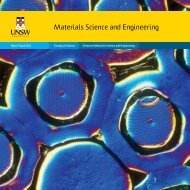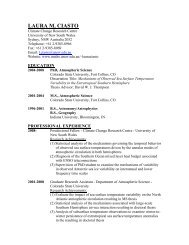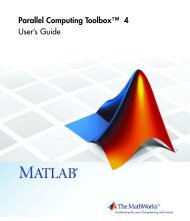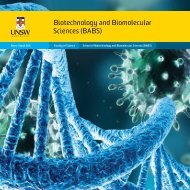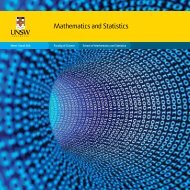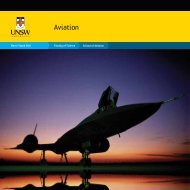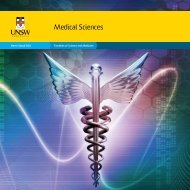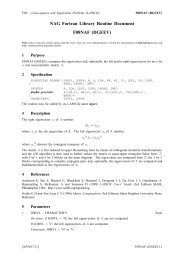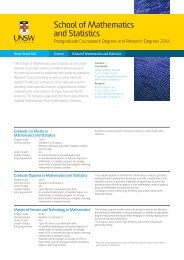2011 Postgraduate Research Competition - UNSW Science - The ...
2011 Postgraduate Research Competition - UNSW Science - The ...
2011 Postgraduate Research Competition - UNSW Science - The ...
You also want an ePaper? Increase the reach of your titles
YUMPU automatically turns print PDFs into web optimized ePapers that Google loves.
Page |3<br />
Reinterpretation of Megatsunami Inundation in<br />
Southeast Australia and the Implications for<br />
Palaeotsunami Identification<br />
Abstract<br />
Claire Courtney, Dale Dominey-Howes, James Goff and Catherine Chague-Goff<br />
School of Biological, Earth & Environmental <strong>Science</strong>s<br />
<strong>The</strong> 2004 Indian Ocean tsunami resulted in a marked increase in concern regarding regions<br />
previously considered low risk of tsunami inundation. <strong>The</strong> southeast coast of Australia has a<br />
record suggesting low tsunami risk, with only 47 small tsunamis striking since European arrival.<br />
However, the controversial megatsunami hypothesis suggests patterns of massive inundation<br />
of the east Australian coast. Given the extreme vulnerability of the NSW coastline due to<br />
population concentration and the reliance on boulder deposit evidence, there is a need to<br />
provide thorough re-evaluation of the Australian tsunami risk.<br />
This re-examination has led to research at four back-beach locations on the south coast of<br />
New South Wales, located close to sites reported to contain evidence of megatsunami<br />
inundation. Analysis of stratigraphy, sediments, geochemistry and microfossils, plus an<br />
extensive radiocarbon chronology of these sites allows for a full reconstruction of the<br />
Holocene environments. This success highlights the importance of using multi-proxy<br />
diagnostic techniques in investigating potential tsunami inundation sites with relatively short<br />
historical records. In the case of NSW, no evidence of Holocene tsunamis has been identified,<br />
casting serious doubt on the existing understanding of tsunami risk on the NSW coast and the<br />
diagnostic criteria used for identifying tsunami deposits.<br />
Abstract<br />
Do animals on the ground really need trees<br />
Alan Kwok and David Eldridge<br />
School of Biological, Earth & Environmental <strong>Science</strong>s<br />
Mallee woodlands are an important ecological community in semi-arid eastern Australia,<br />
whose distribution has been substantially reduced since European settlement. Within mallee<br />
communities, substantial leaf litter accumulates around the trees, while the areas between<br />
the trees are virtually litter–free. Consequently the community is dominated by two major<br />
patch types; deep dense litter and bare soil. My research focuses on arthropod (insects,<br />
spiders, slaters) use of these two patches, and indicates that leaf litter is a crucial component<br />
of these mallee ecosystems, structuring fine- and broad-scale biodiversity. In areas not burnt<br />
by fire for several decades, leaf litter is abundant under the tree canopy and supports a<br />
different composition of arthropods such as slaters and jumping spiders, compared to areas<br />
devoid of leaf litter. In contrast, in recently burnt communities, the area under the tree<br />
canopy has considerably less leaf litter and therefore there are fewer differences between<br />
canopy and open areas. Furthermore, slaters are virtually absent in recently burnt<br />
communities. My research illustrates that patterns of arthropod biodiversity in mallee<br />
woodlands are dependent upon environmental characteristics that vary over tens of metres<br />
(leaf litter), and that this is intrinsically tied to broad-scale ecological processes such as fire.<br />
|climate, environment & sustainability



